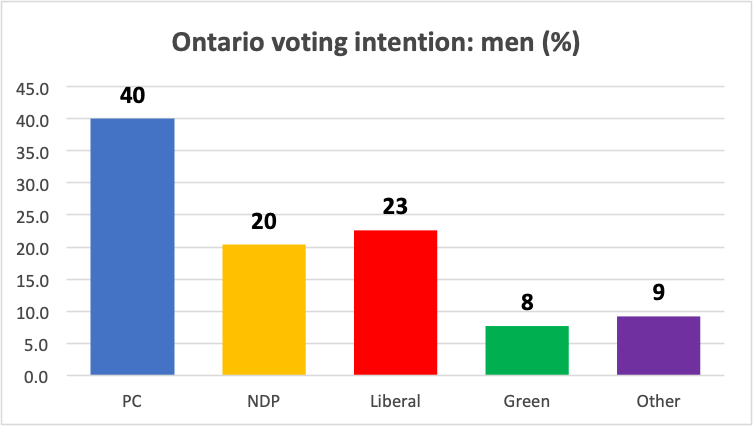Our content is fiercely open source and we never paywall our website. The support of our community makes this possible.
Make a donation of $35 or more and receive The Monitor magazine for one full year and a donation receipt for the full amount of your gift.
A lot can happen between now and June 2, but if pollsters are right, Ontario is looking at a PC majority government from now to 2026.
It won’t be because of women.
Based on published polls, Premier Doug Ford’s party appears to have the support of roughly 36% of voters, with the Liberals and the NDP trailing behind at 27% and 24% respectively. Thanks to vote splits and our 19th-century voting system, the PCs can expect to win about 60% of the seats at Queen’s Park—and 100% of the decision-making power.
But if the outcome was decided solely by how women vote, the results would be dramatically different.
Recent polling by Mainstreet Research suggests that if only women voted, the three parties with the most support would be running a very close race. Mainstreet data, as of May 24, suggests that 31.3% of women support the PCs, 27.6% the NDP, and 27.4% the Liberals.

If only women voted, vote splitting would still be a big factor on election day, but no one party would benefit from the splits. The resulting seating plan in the legislature would be very different from what it is now.
Adjusting the 2018 election results by the latest Mainstreet numbers for women, the PCs could well win the most seats, but they would not win a majority. My estimate is that the PCs would end up with 52 seats, the NDP with 38, the Liberals with 33, and the Greens with one.[i]

In this scenario, and with the Liberals, New Democrats, and Greens all on record saying they won’t support a PC minority, a government that reflected women’s voting preferences would almost certainly take Ontario in a different direction from what the PCs are proposing.
This is not, of course, the outcome pollsters are predicting. That’s because of one group: men. Mainstreet pegs PC support among men at 40%, with the New Democrats well back at 23% and 20% respectively.

If only men voted, the PC party might well end up with two-thirds of all seats. Unlike in past elections, where the non-PC vote was mostly split between the Liberals and the NDP, a rising Green Party and various new right-wing parties are now fragmenting the vote even further. Given this, the final men-only outcome on June 2 might see the PCs take 82 seats. The NDP would trail with 27, the Liberals with 14, and the Greens again with one.

This is a rough estimate only that doesn’t take into account local factors. But as things stand now, the gender divide will play a major part in the outcome on June 2, just as it did in the 2018 election. When it comes to voting, it appears that men have different concerns and interests than women, and vice versa—at least enough to be statistically significant.
If the pollsters are right, a large majority of women in Ontario want change on June 2. Whether they get it remains to be seen.
[i] Seat estimates are based on the difference between actual 2018 election results by riding and Mainstreet’s estimates of province-wide party support by gender as of May 24, 2022. Non-binary respondents are not factored into seat estimates due to small sample size.


